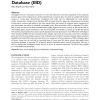Free Online Productivity Tools
i2Speak
i2Symbol
i2OCR
iTex2Img
iWeb2Print
iWeb2Shot
i2Type
iPdf2Split
iPdf2Merge
i2Bopomofo
i2Arabic
i2Style
i2Image
i2PDF
iLatex2Rtf
Sci2ools
BIB
2006
2006
Advances in the Exon-Intron Database (EID)
Investigation of exon^intron gene structures is a non-trivial task due to enormous expansions of the eukaryotic genomes, great variety of gene forms, and the imperfectness in sequence data. A number of available informational systems on various gene characteristics complement each other and are indispensable for many genomic studies. Among them, the Exon-Intron Database (EID) is a good choice for large-scale computational examination of exon/intron structure and splicing. It has many internal filters that control for sequence quality, consistency of gene descriptions, accordance to standards, and possible errors. New innovations in EID are described. The collection of exons and introns has been extended beyond coding regions and current versions of EID contain data on untranslated regions of gene sequences as well. Intron-less genes are included as a special part of EID. For species with entirely sequenced genomes, species-specific databases have been generated. A novel Mammalian Orth...
| Added | 10 Dec 2010 |
| Updated | 10 Dec 2010 |
| Type | Journal |
| Year | 2006 |
| Where | BIB |
| Authors | Valery Shepelev, Alexei Fedorov |
Comments (0)

